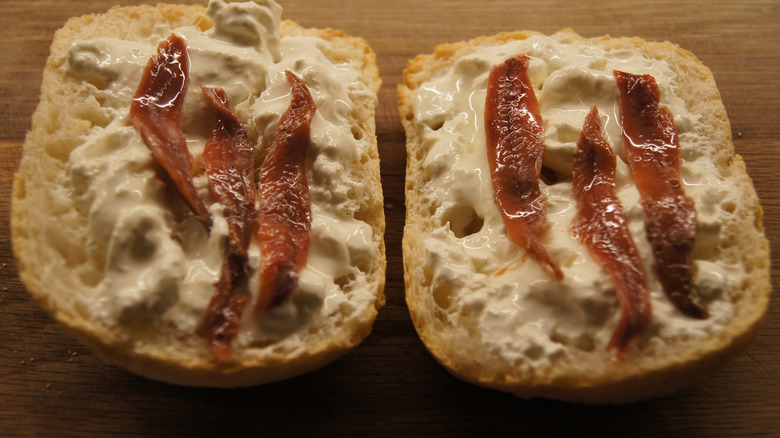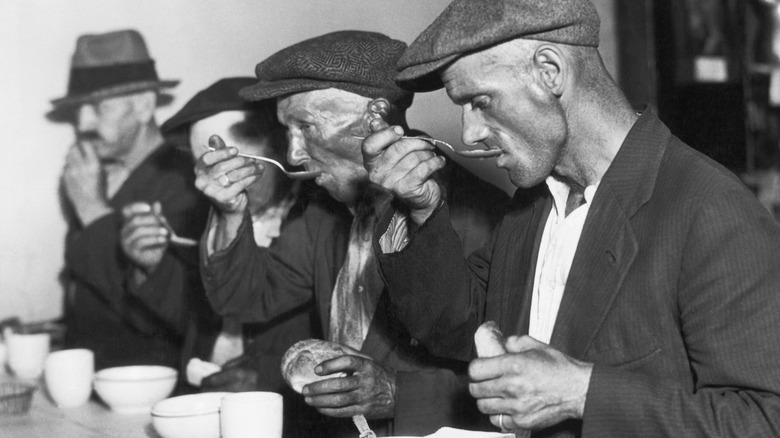In 1935, a baffling sandwich recipe was concocted, bound into a cookbook, and pitched to consumers: The pineapple anchovy cheese sandwich. This unlikely trio — anchovies, cream cheese, and canned pineapple — reflects the inventive experimentation and simple ingredients of American 1930s home cooking. Reportedly the brainchild of pineapple industry publication “Five Feet of Flavor,” the recipe’s intent was clear: Promote pineapple as a versatile pantry staple. The combo of sugary pineapple with salty fish and thick cream cheese may seem a bit wild, but this combination was likely crafted with knowledge of prevailing tastes in 1930s America.
The sweet-and-savory combination was big at a time when American cooks were trying to make the best of limited food options and empty wallets during the Great Depression. The call for canned pineapple and anchovies leans into another food trend of the time period: The rise of processed and canned foods at a time when convenience, affordability, and shelf life were paramount. This everything-in-the-pantry combo may not seem ideal to all modern foodies, but even sandwiches go through trends.
So you want to try the pineapple anchovy cheese sandwich
If you’re ready to give this vintage sandwich a gander, go with some classic canned pineapples (rather than fresh) to stay true to the 1930s ethos. Make sure you drain the pineapples a bit so they don’t make your sandwich soggy. In regards to cream cheese, go for a full-fat version to get the full impact of the salt and richness. For a sandwich with heft and sophistication, try a white farm loaf, ciabatta, or, if you have a sourdough starter ready at home, some sourdough.
One YouTube reviewer suggests you stop there in your sandwich construction: “The saltiness in the cream cheese and the pineapple actually worked well together, it’s just the fishy flavor of the anchovies did not work well with the pineapple and the cream cheese in my opinion.” For those ready to commit to the recipe (or if you’re Giada De Laurentiis, who thinks we should all be eating more anchovies), add in some salted anchovy fillets. Look for anchovies that are canned or jarred, but not marinated — this recipe is already a mish-mash of flavors and there’s no need to go overboard. Layer in your anchovies, take a bite, and see if you have the tastes of a 1930s chef!
The thrifty food trends of the 1930s
This pineapple anchovy cheese sandwich shows some of the ways the Great Depression fundamentally reshaped how Americans approached food. With limited resources and skyrocketing food prices, home cooks were forced to be resourceful, stretching ingredients and repurposing what was readily available into a host of fascinating foods eaten during the Great Depression.
Take, for example, the derisively-named Hoover Stew (christened after president Herbert Hoover). This hearty recipe combines macaroni noodles, tomatoes, and hot dogs because this was what was readily available at the time. Or, consider a dandelion green salad made with the most easy-to-access garden weed to replace expensive vegetables. Another Depression-era trick was the sad-sounding but actually delicious Water Pie, made with, yes, mostly water, but also lots of vanilla and sugar that fill out into a custard.
Beyond recipes, this era also saw the rise of household-name food brands that catered to the penny-pinching cook. Campbell’s, Kraft, and Heinz flourished by offering affordable, shelf-stable products that could be transformed into hearty meals. Casseroles became staples, allowing families to use cheap canned meats and mix-ins to feed more people with less. These may not be the trendy dishes of modern American cooking, but the convenience of canned foods and casseroles have kept them central in our kitchens.







